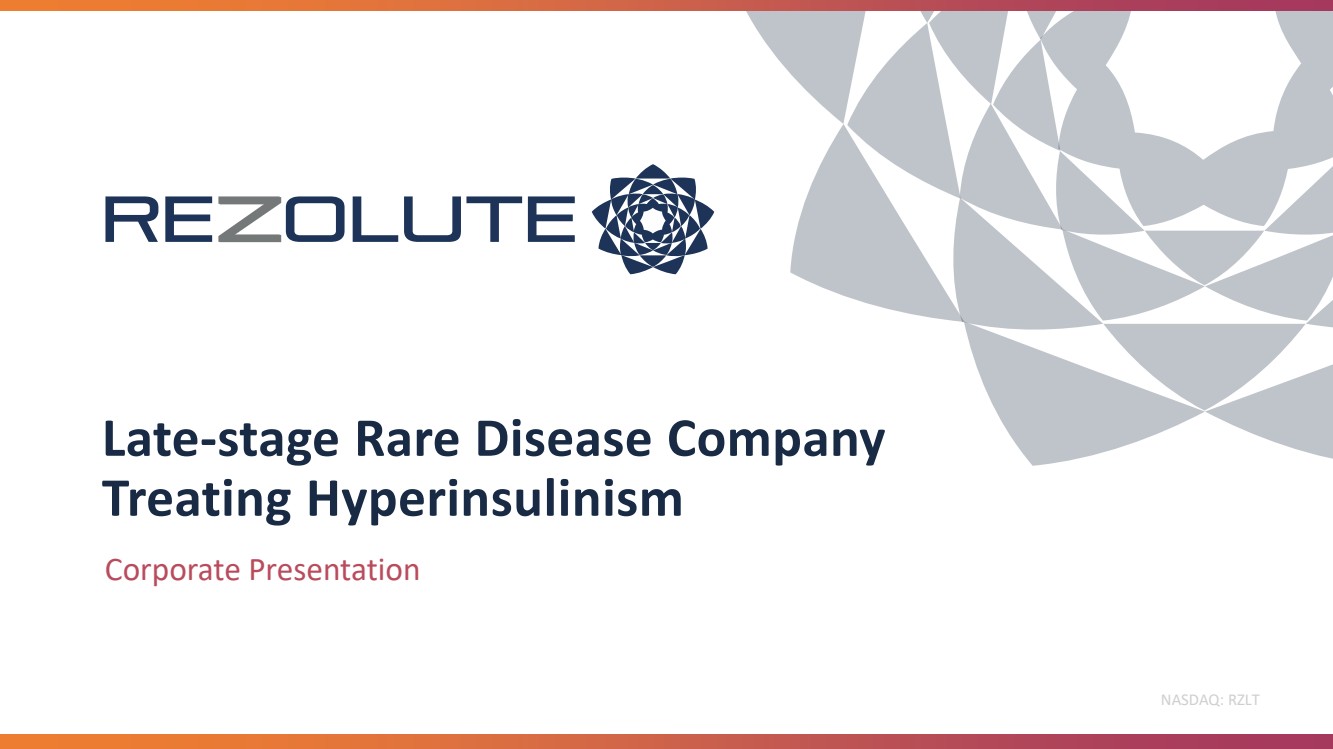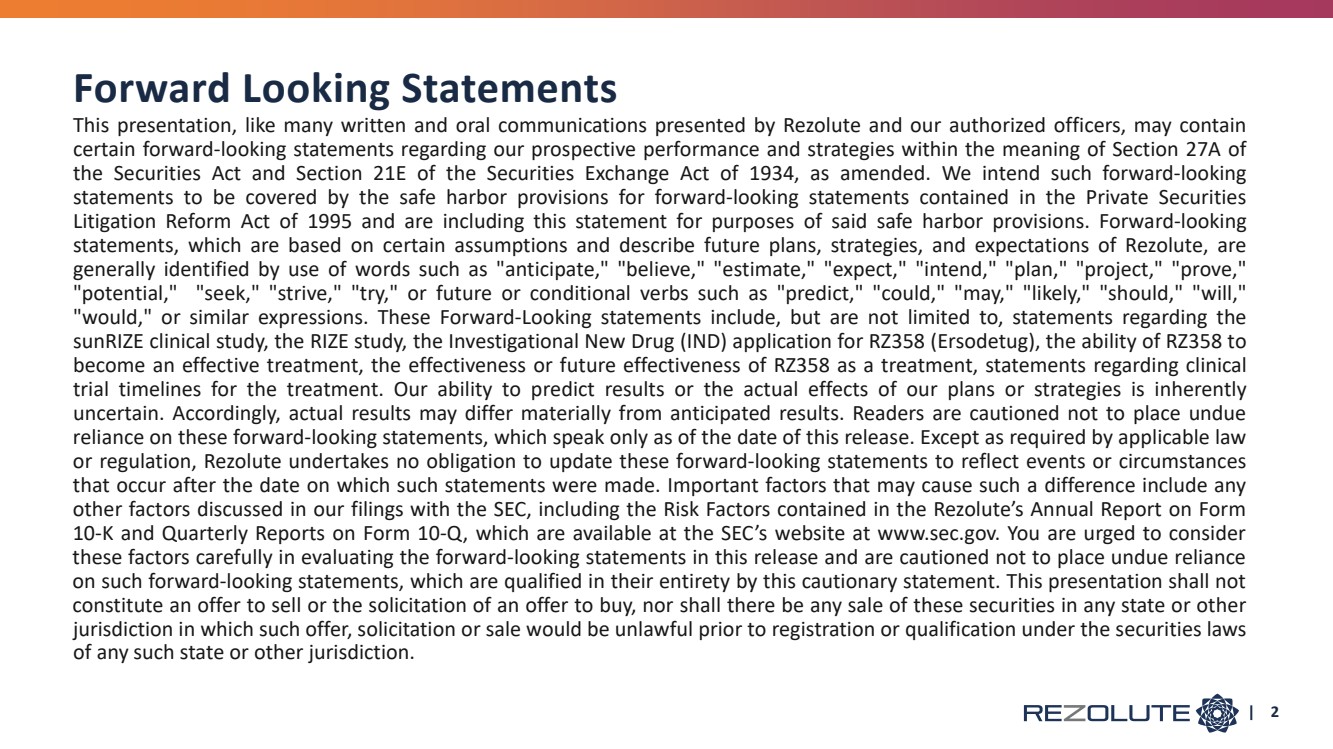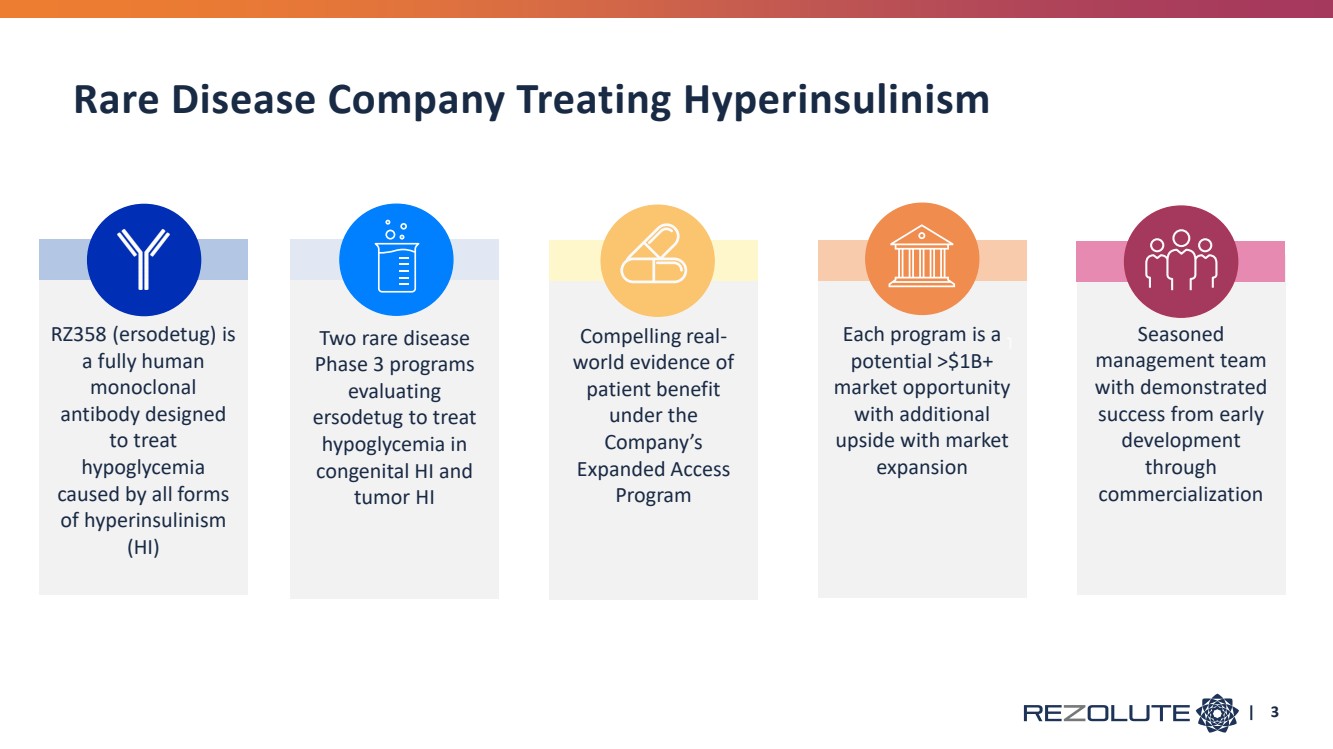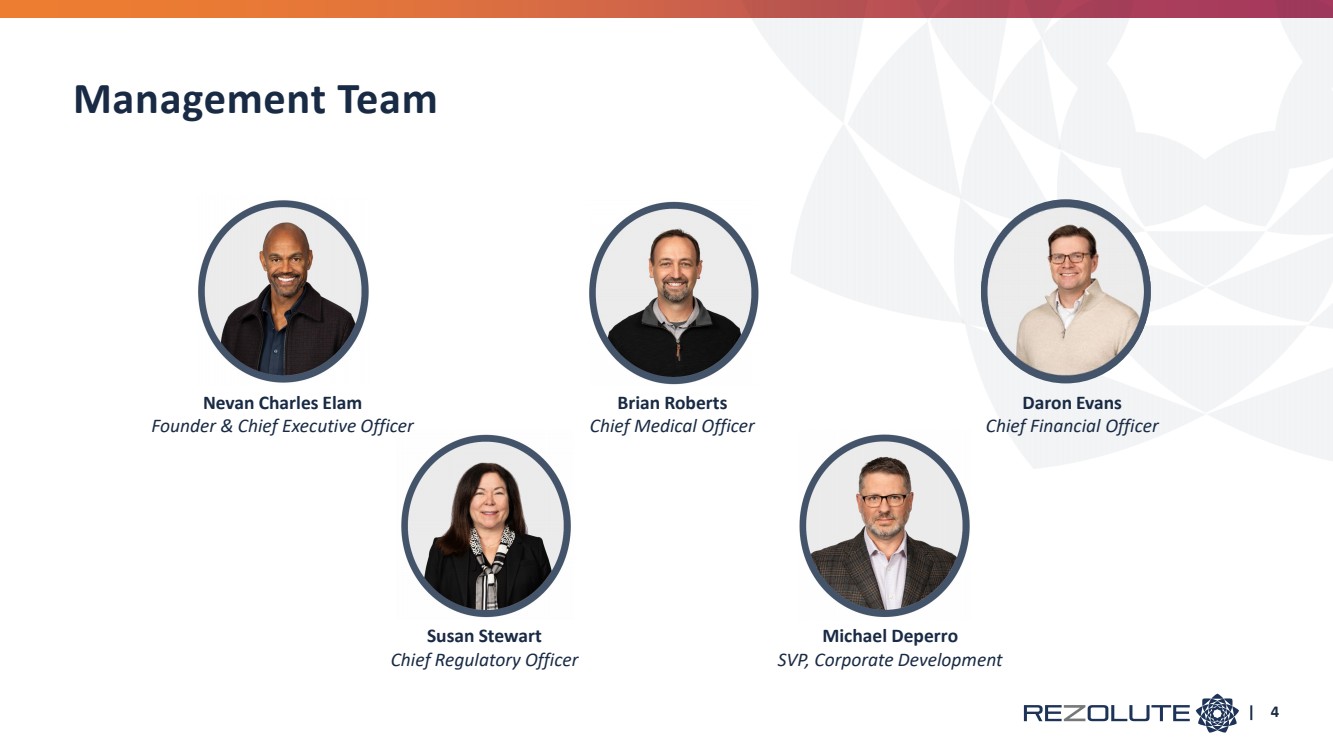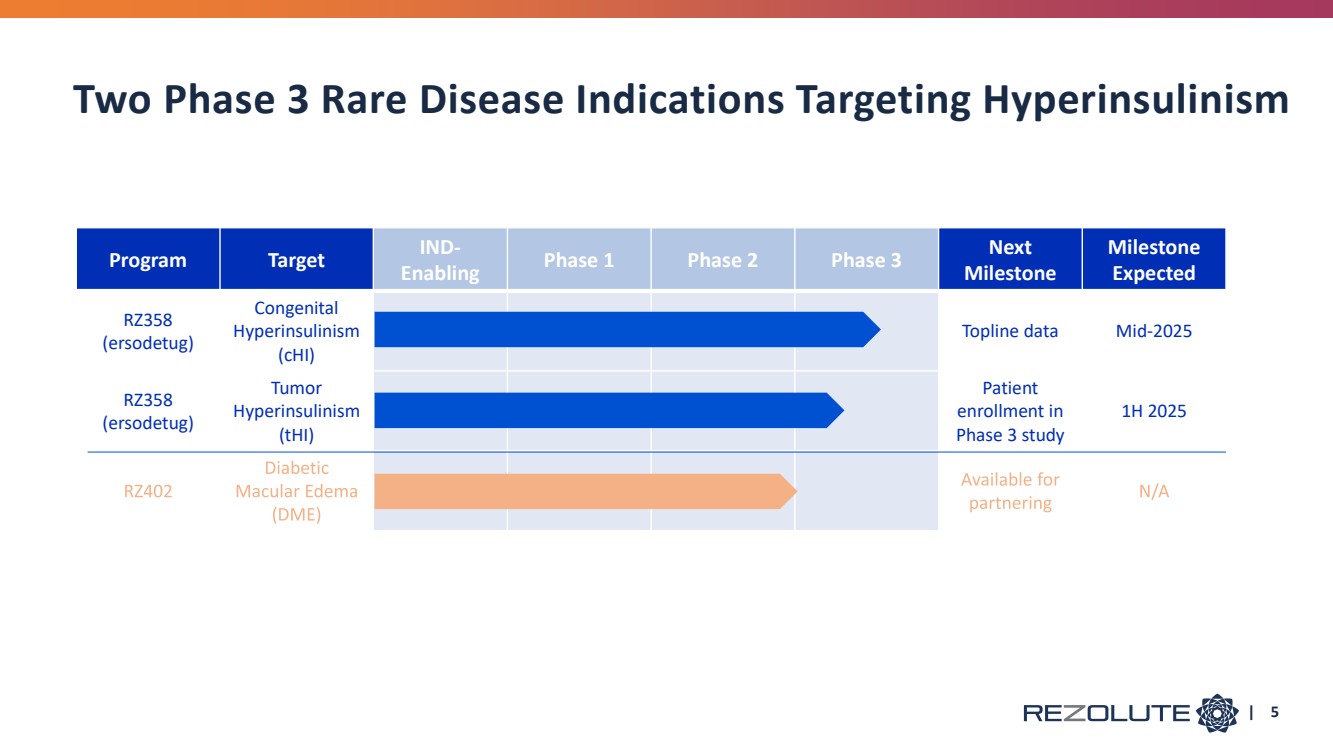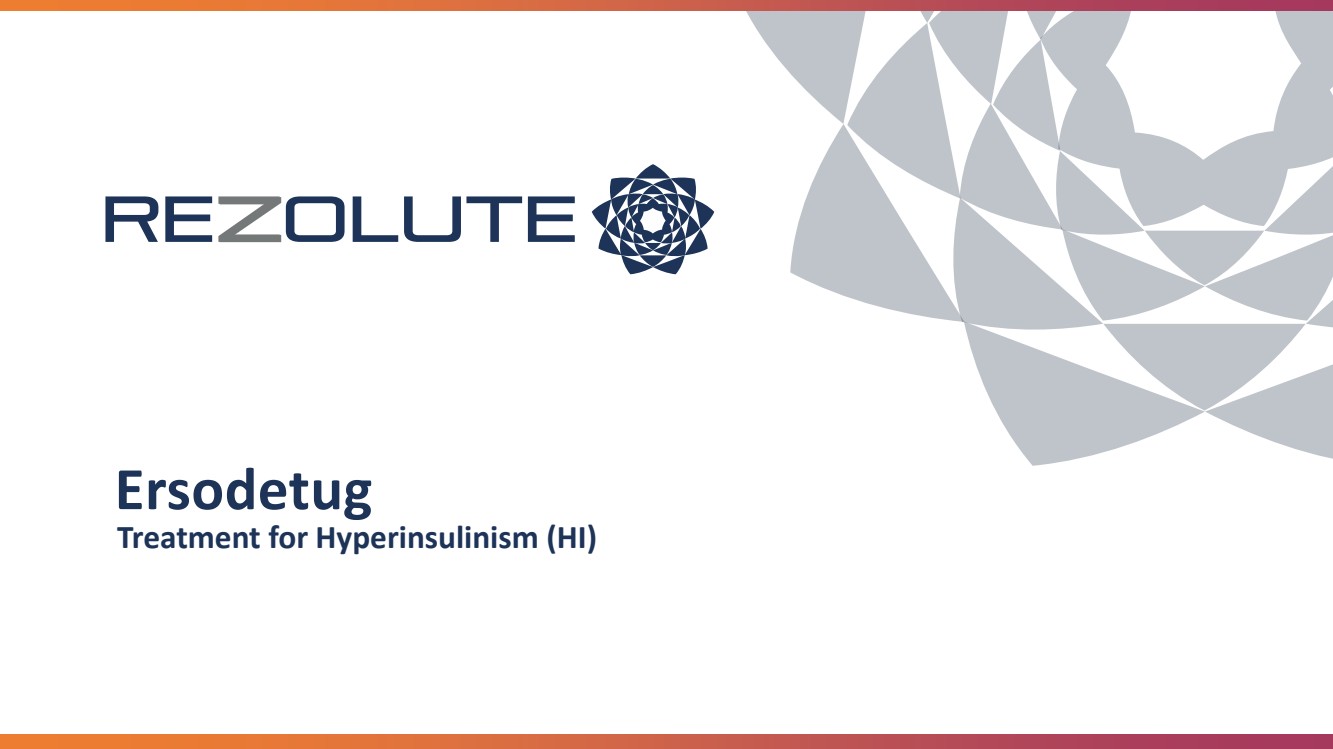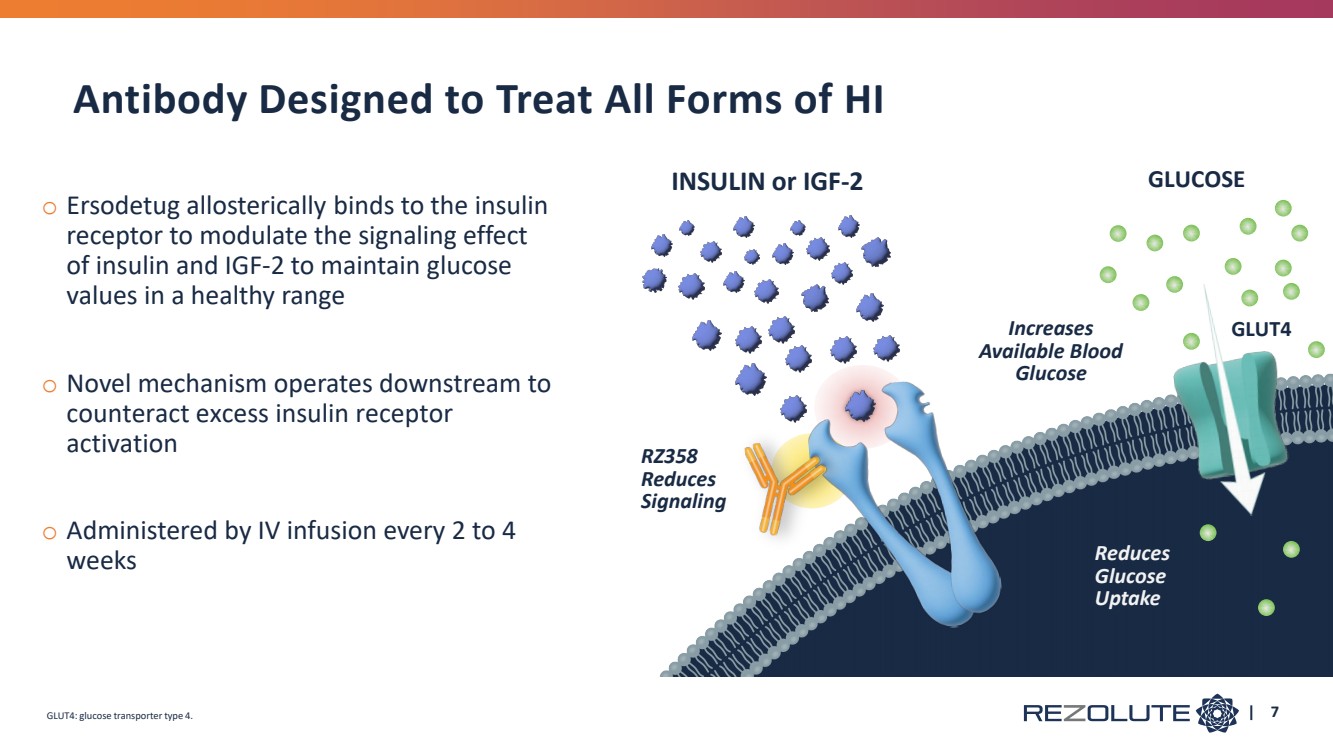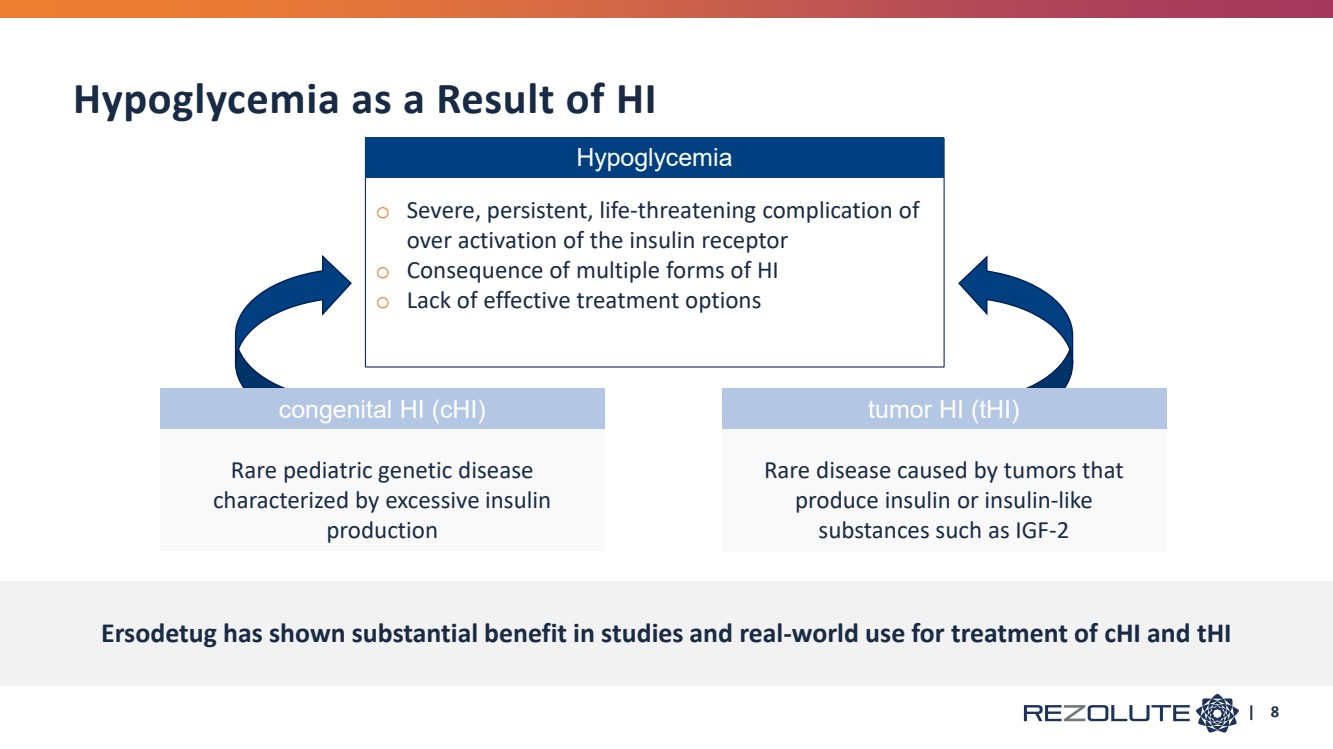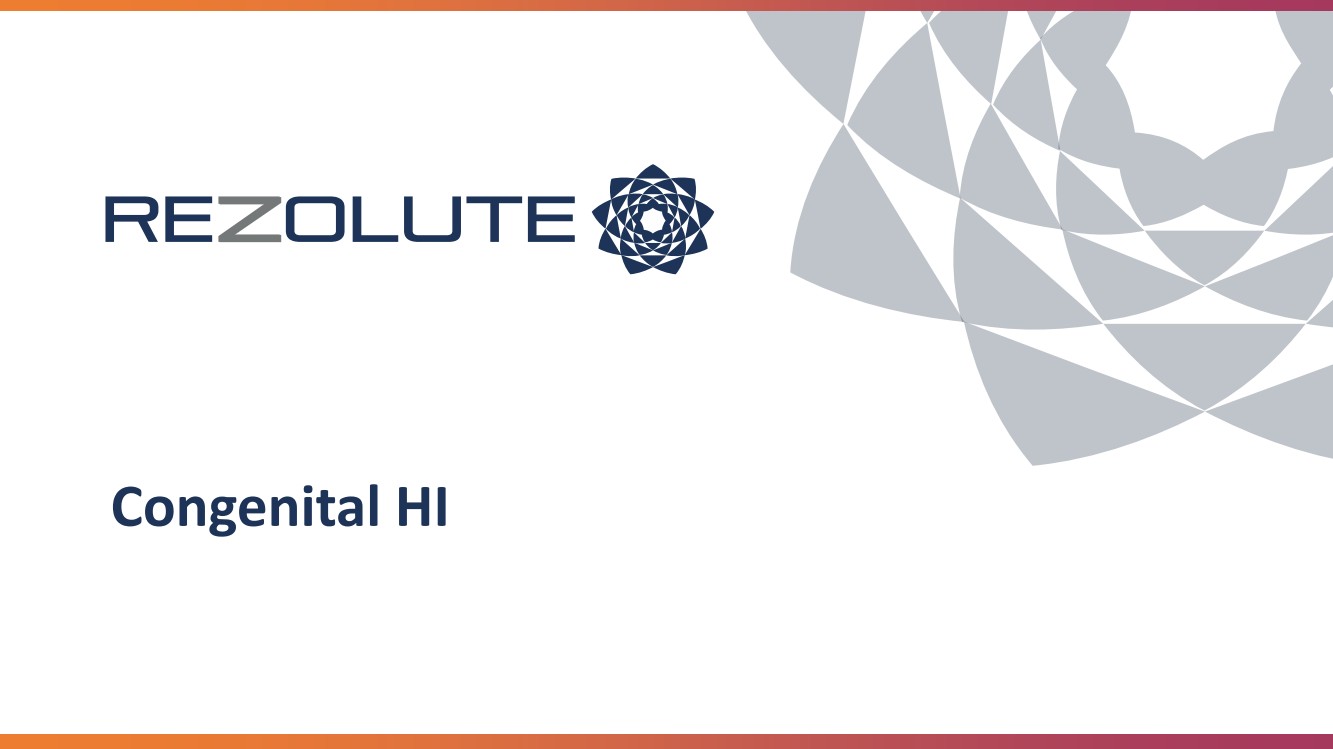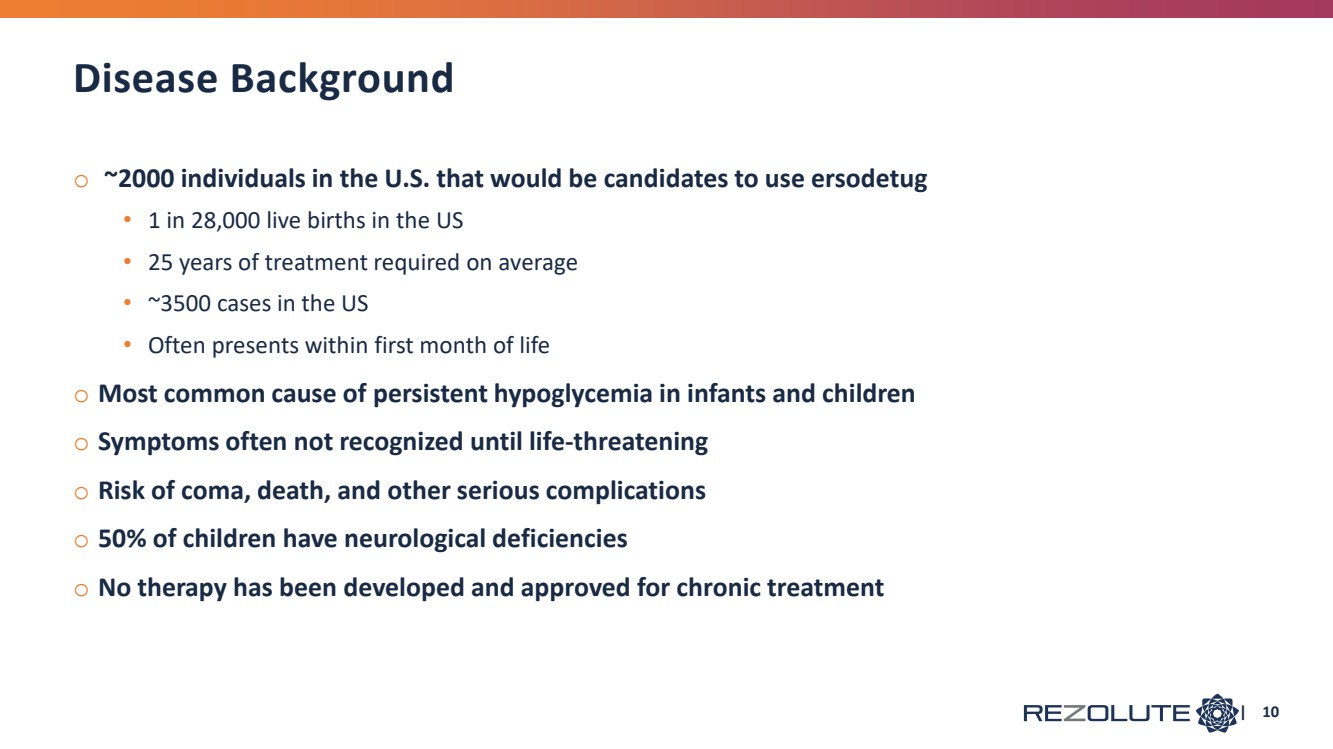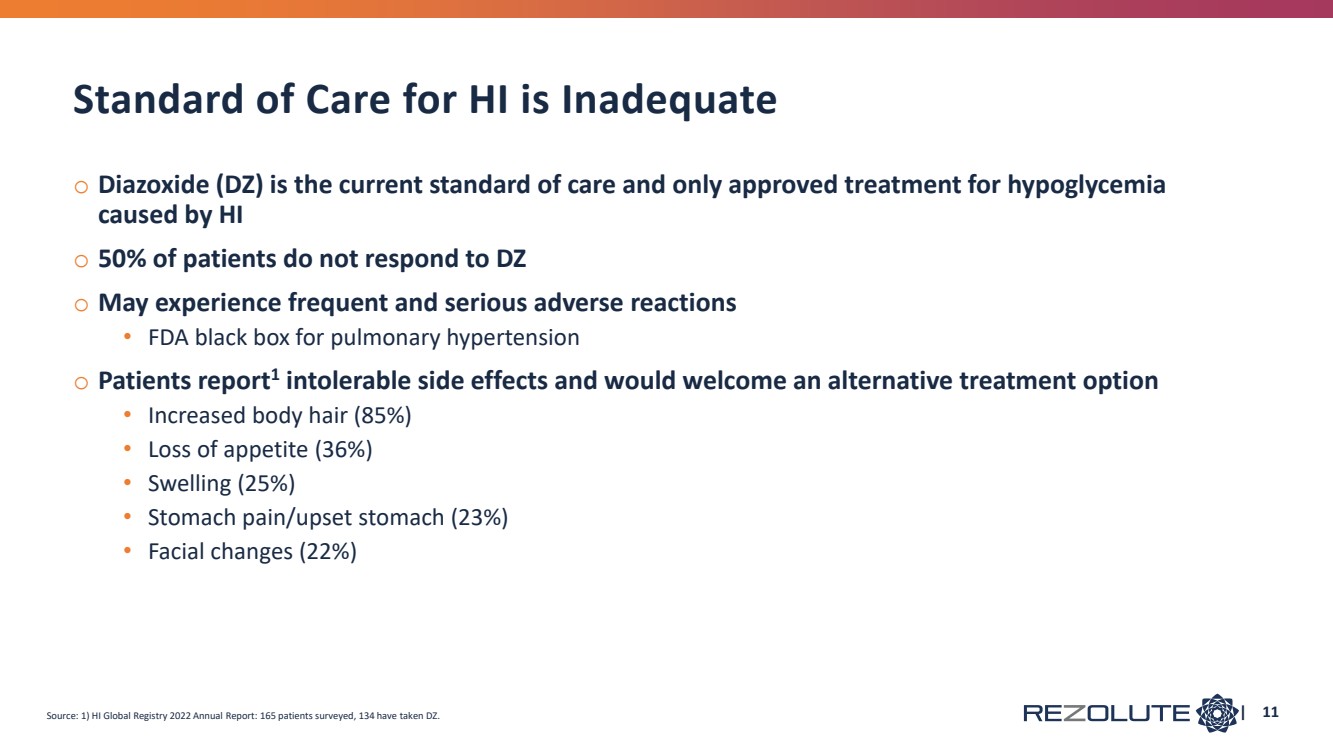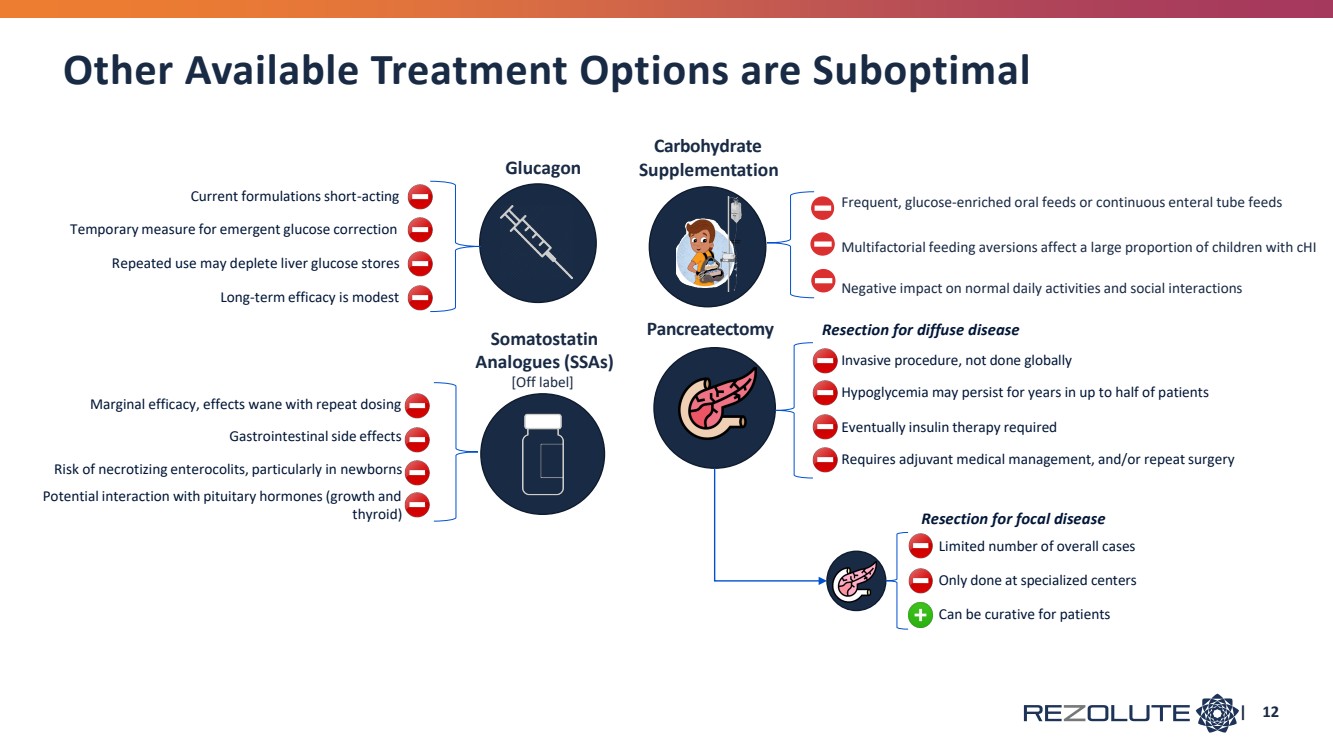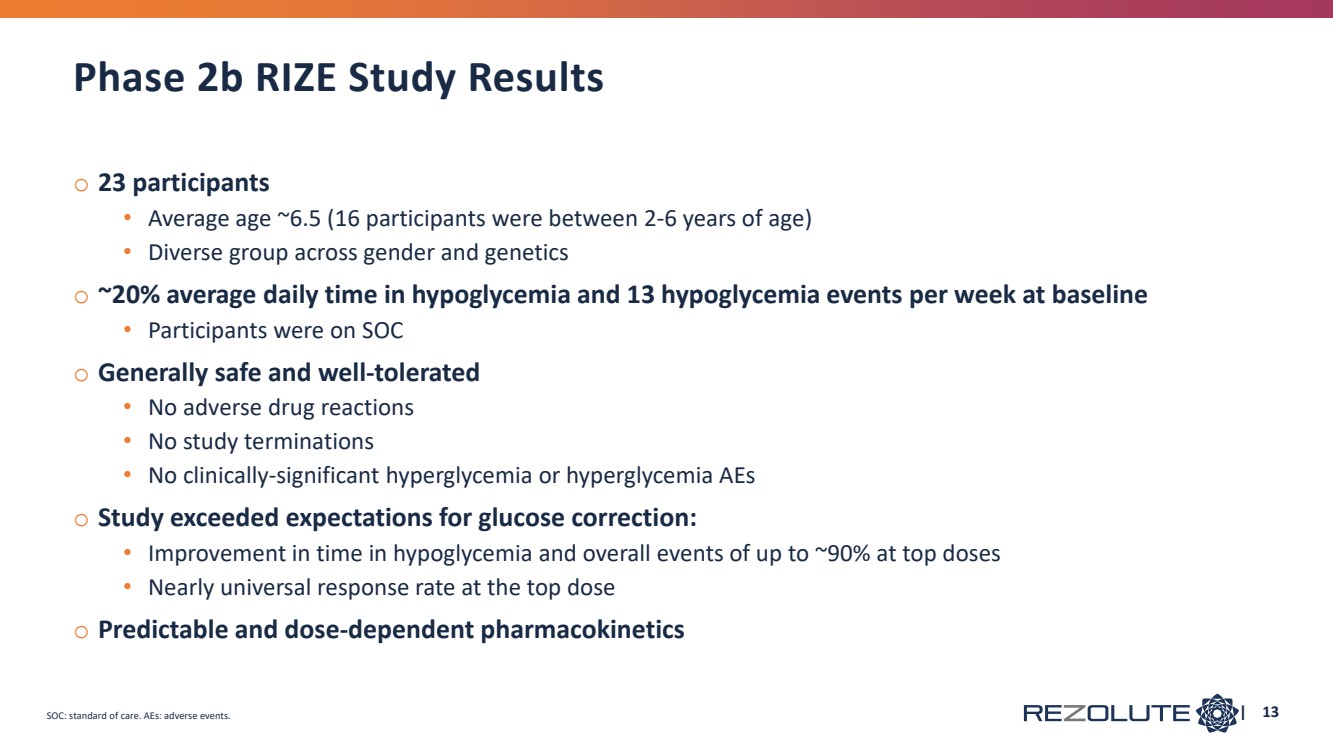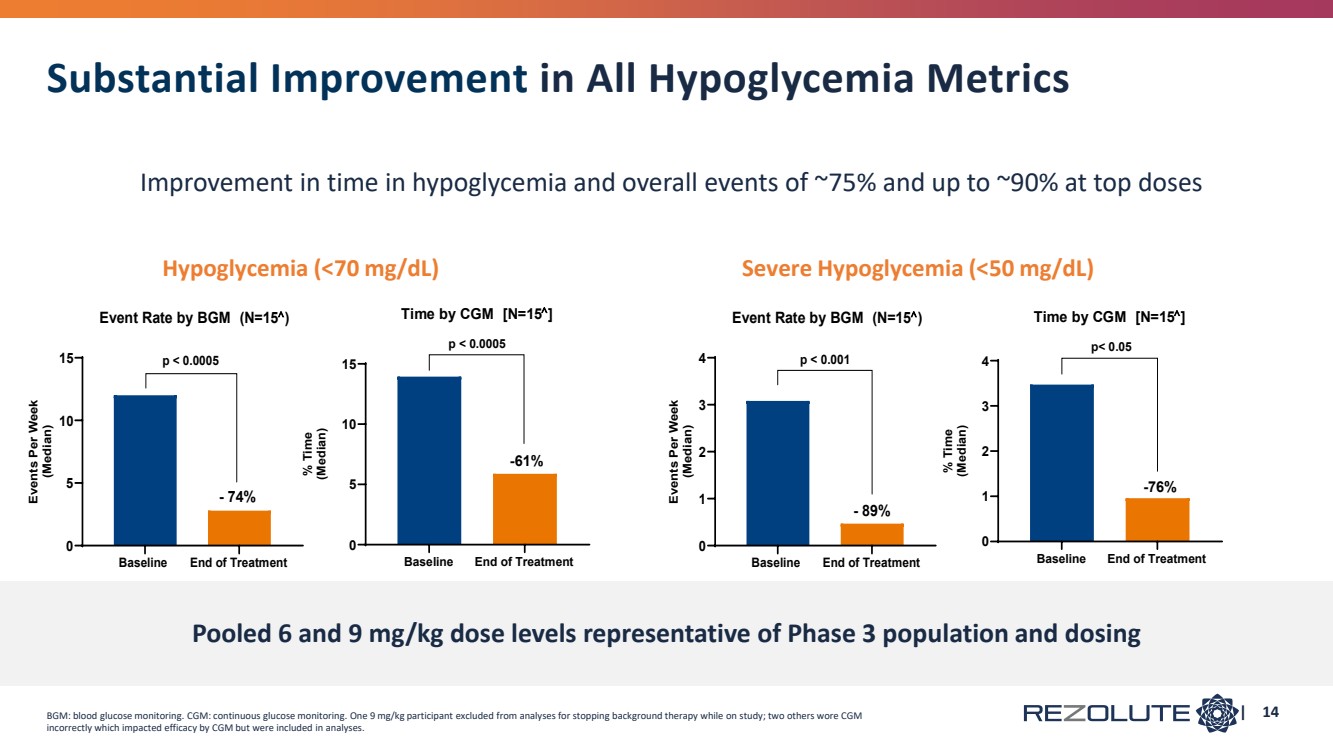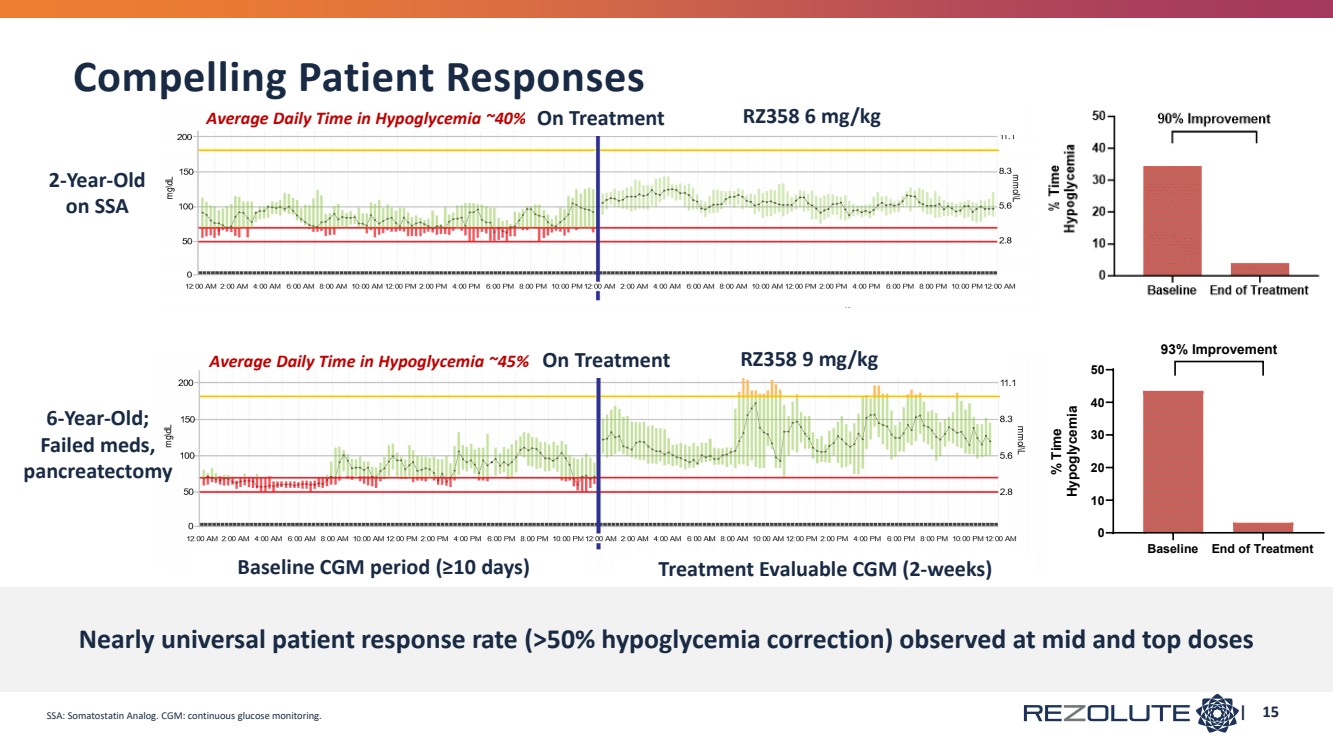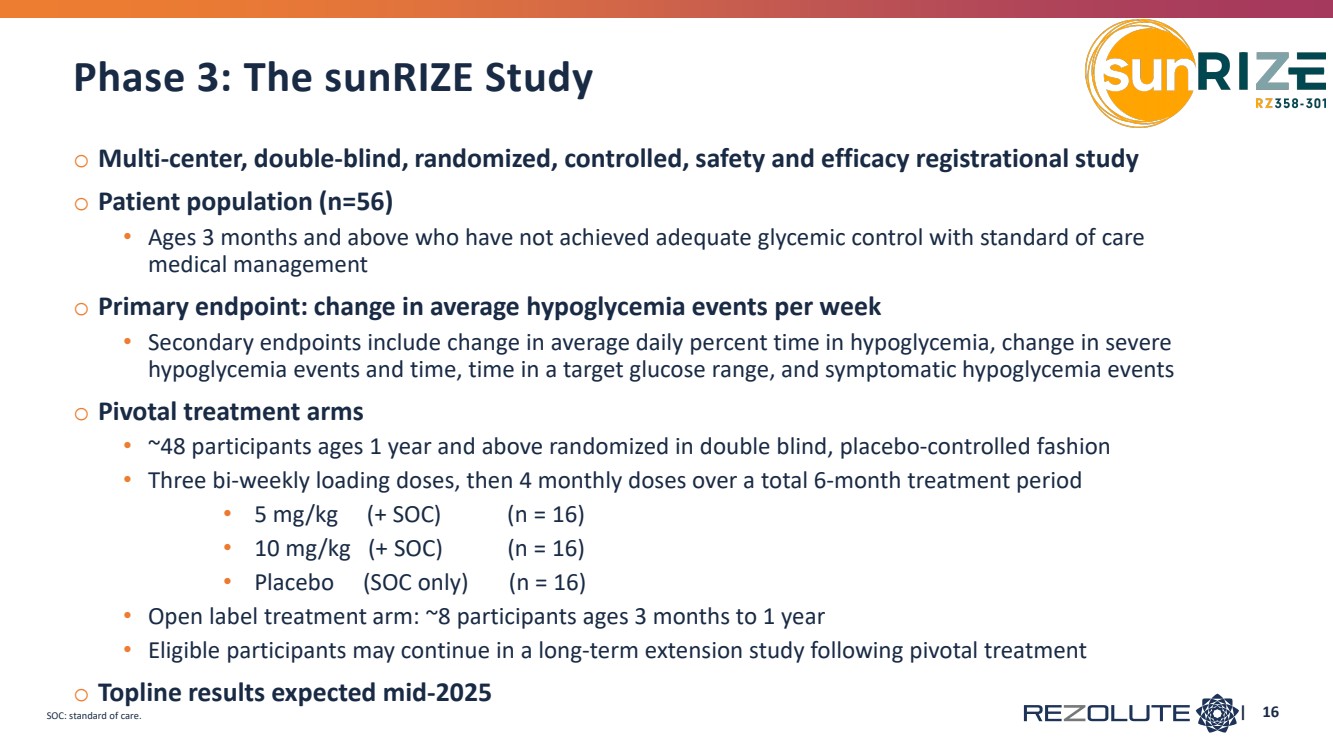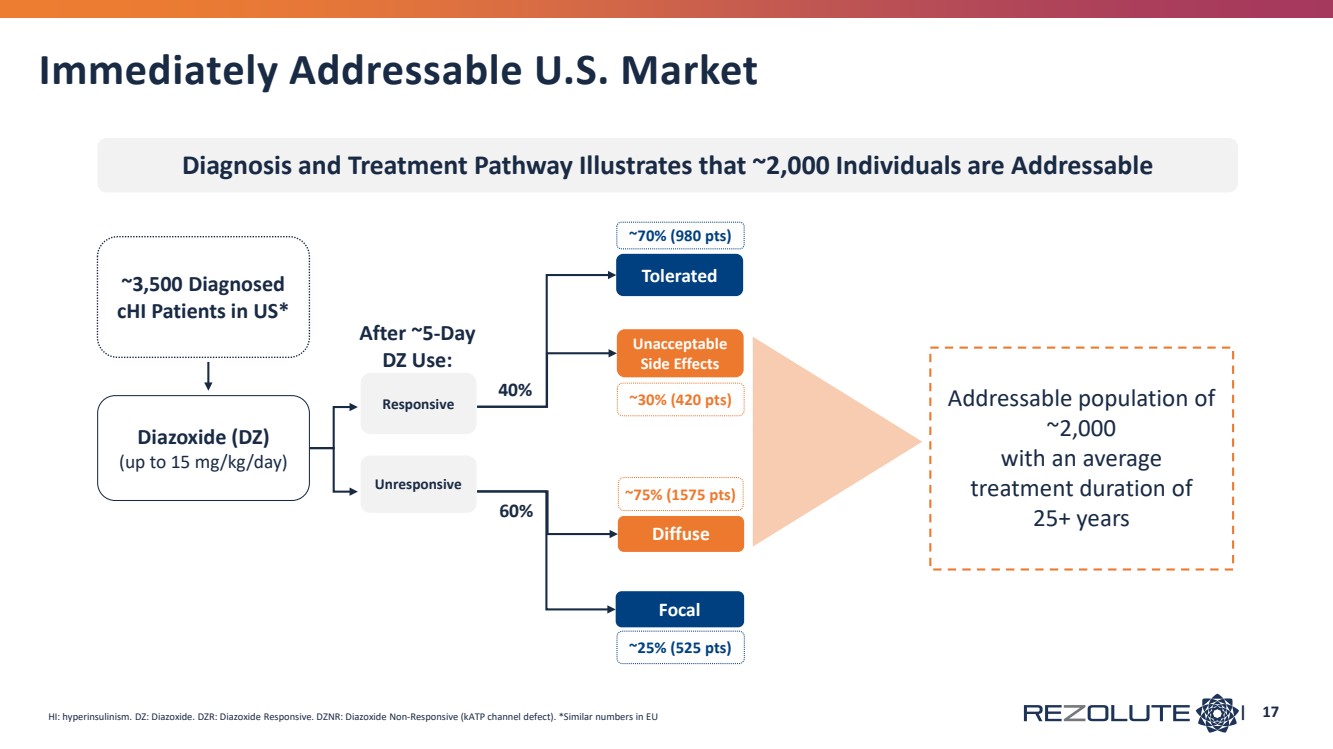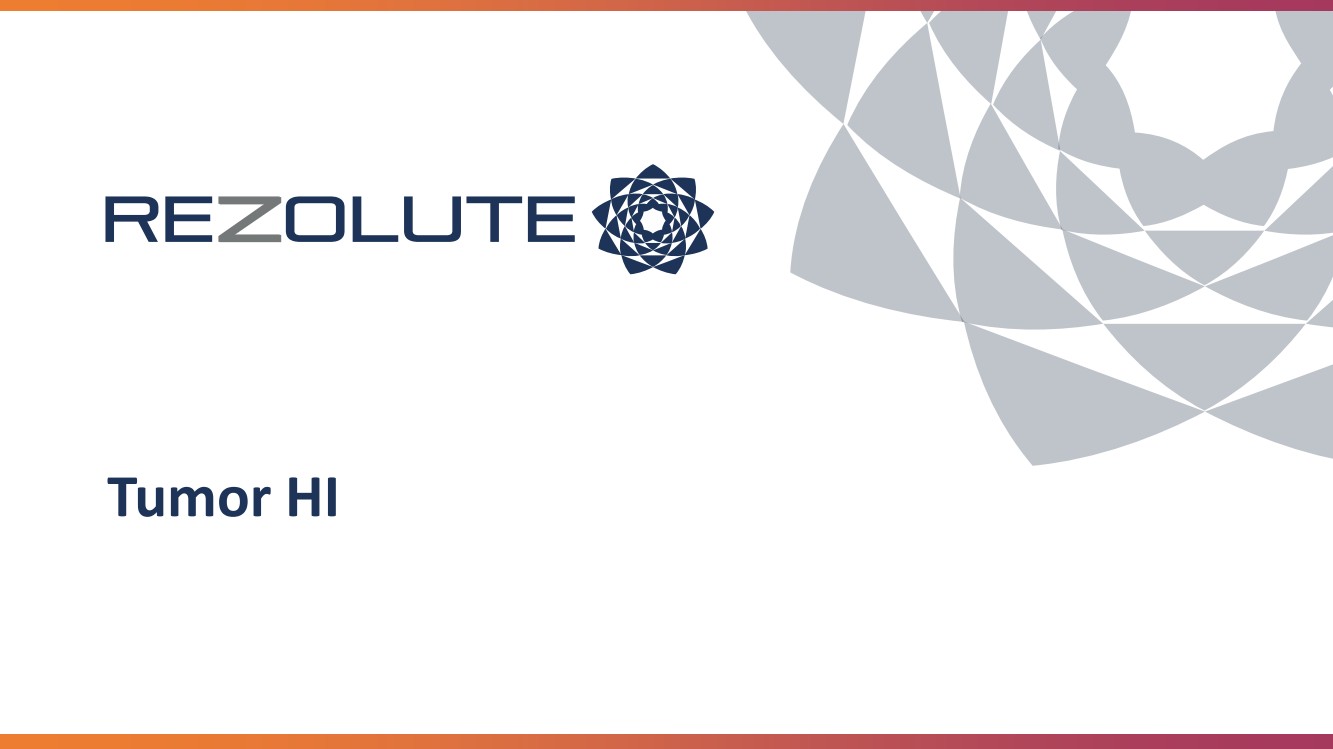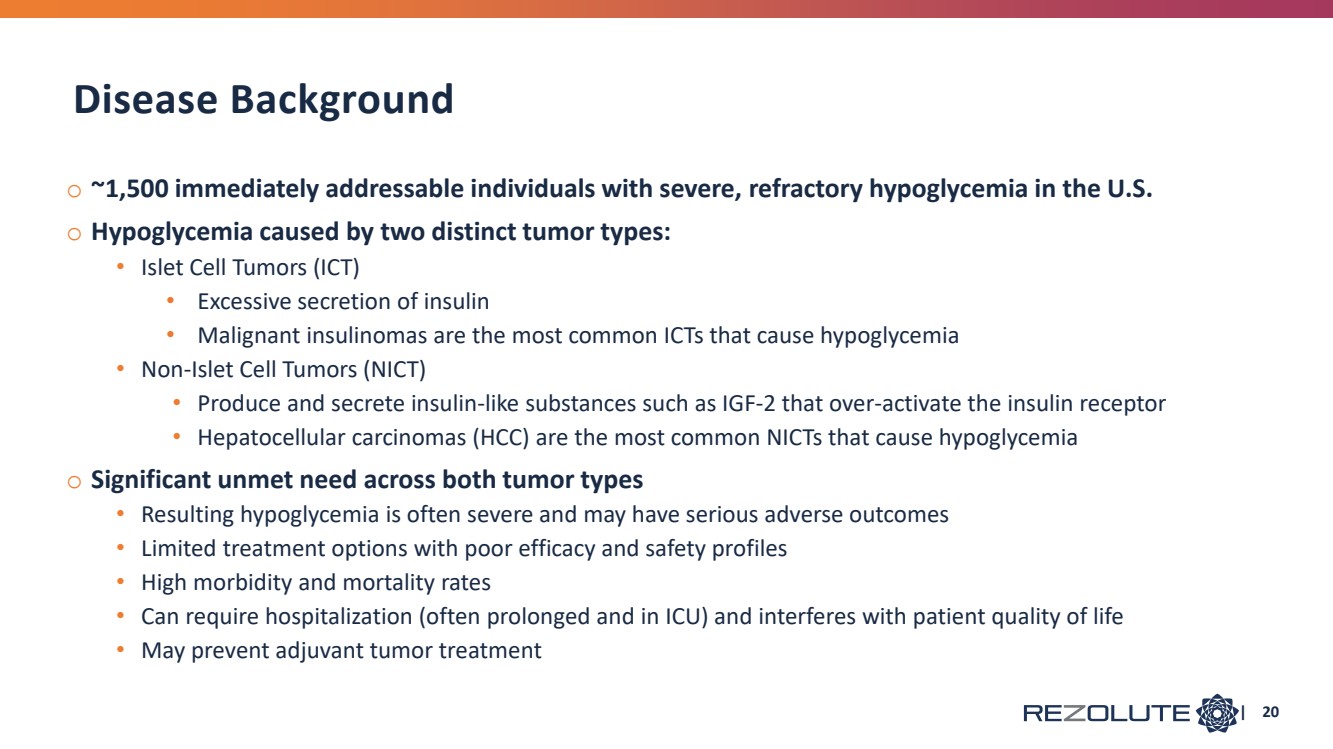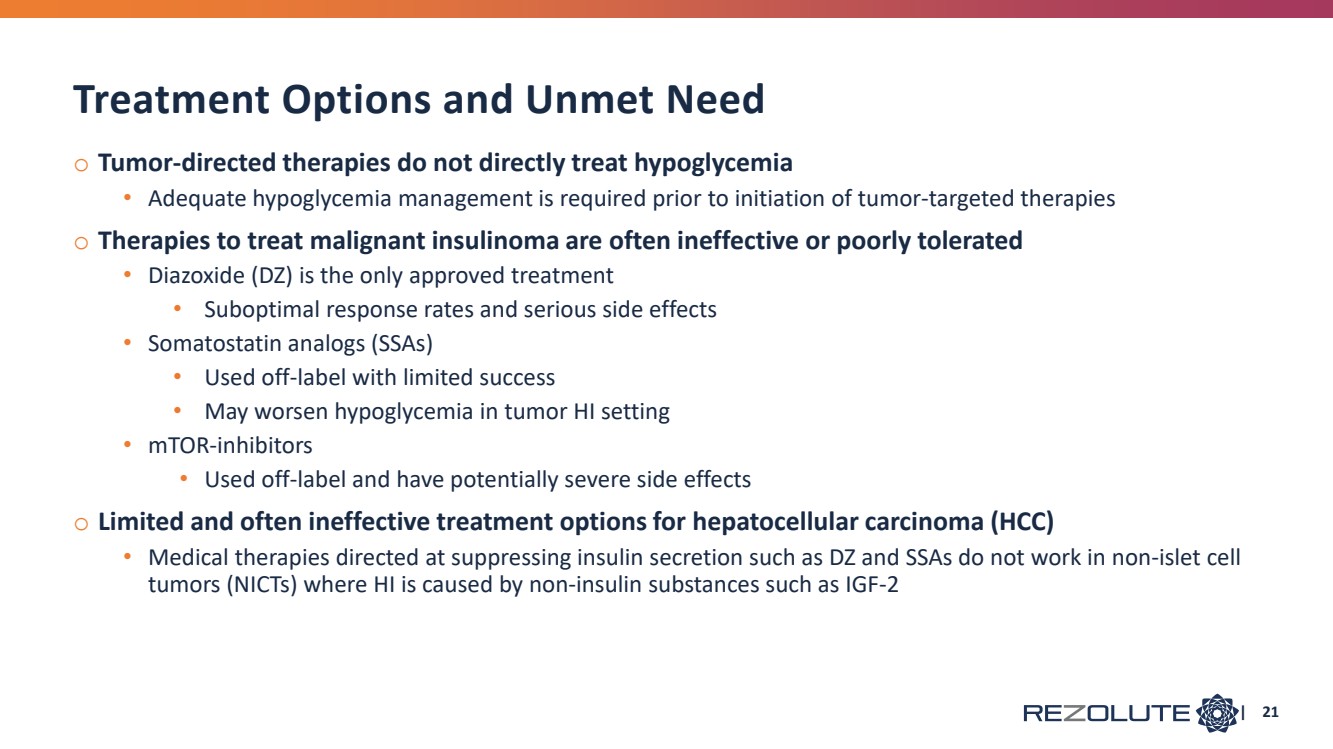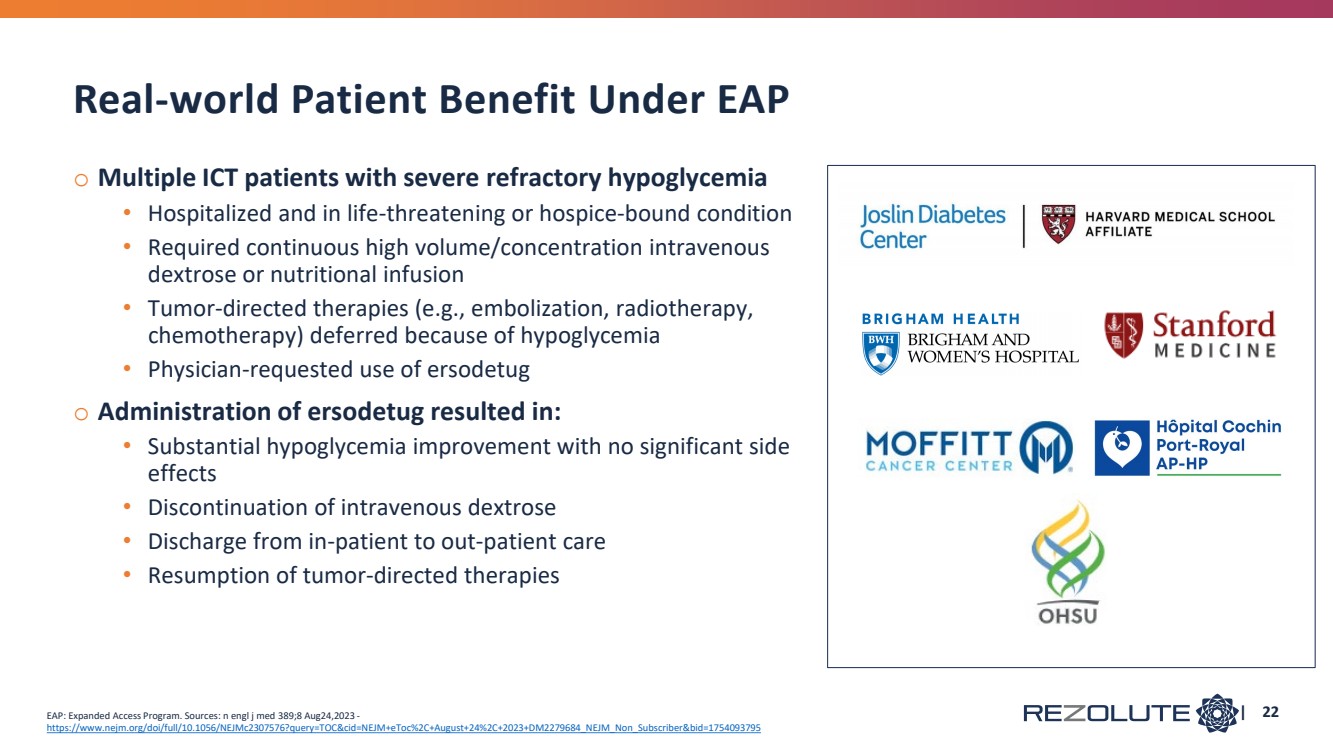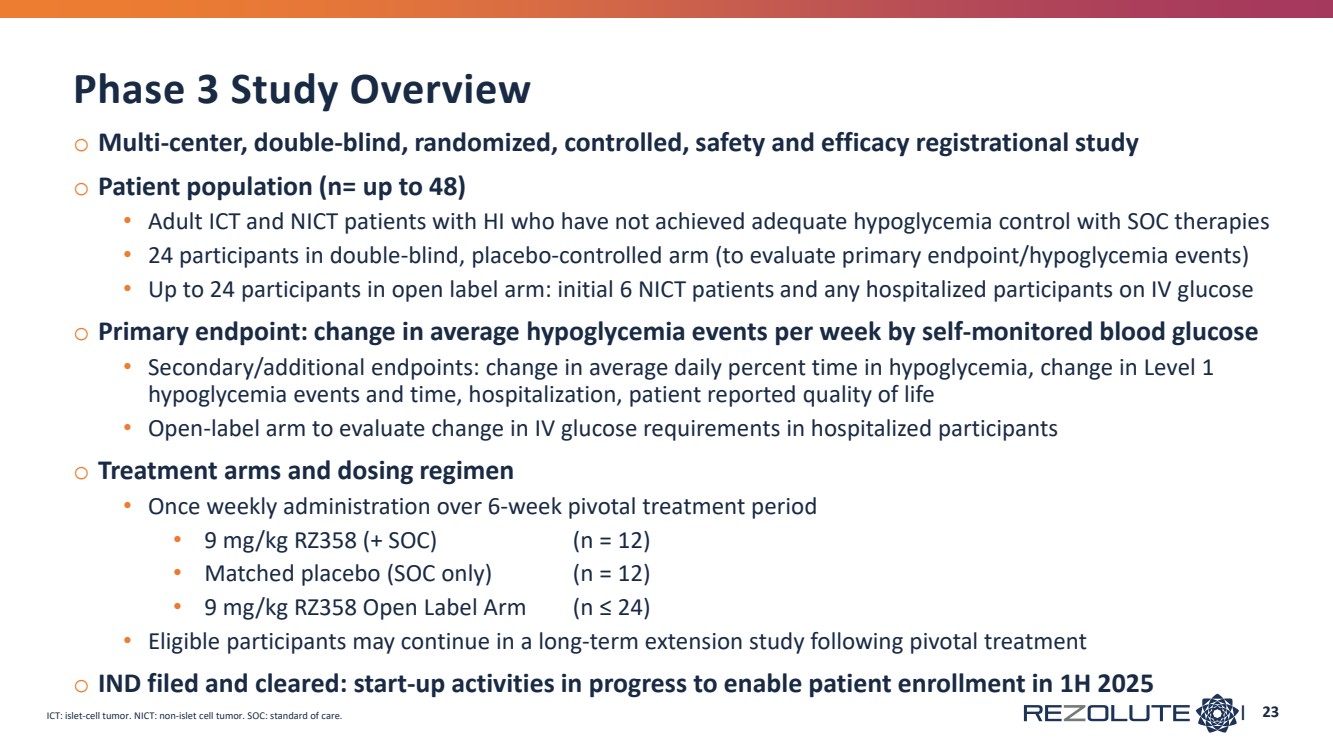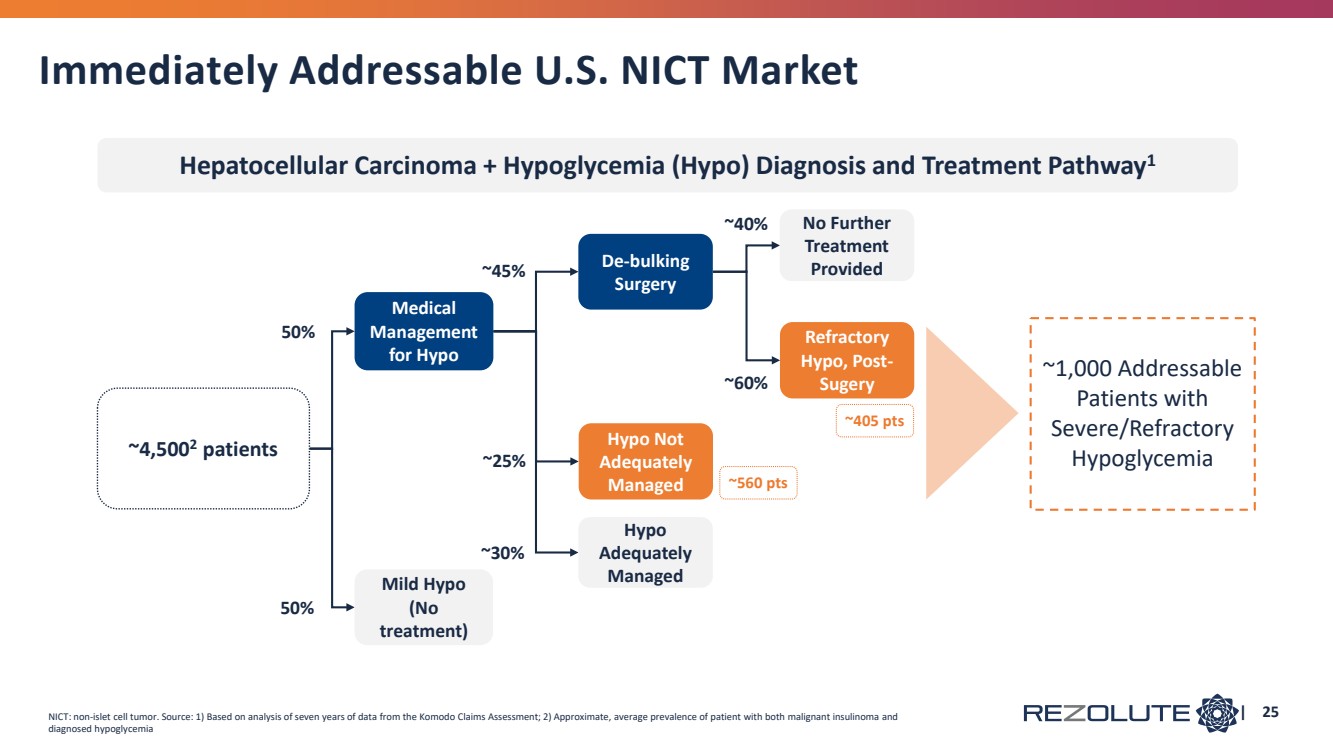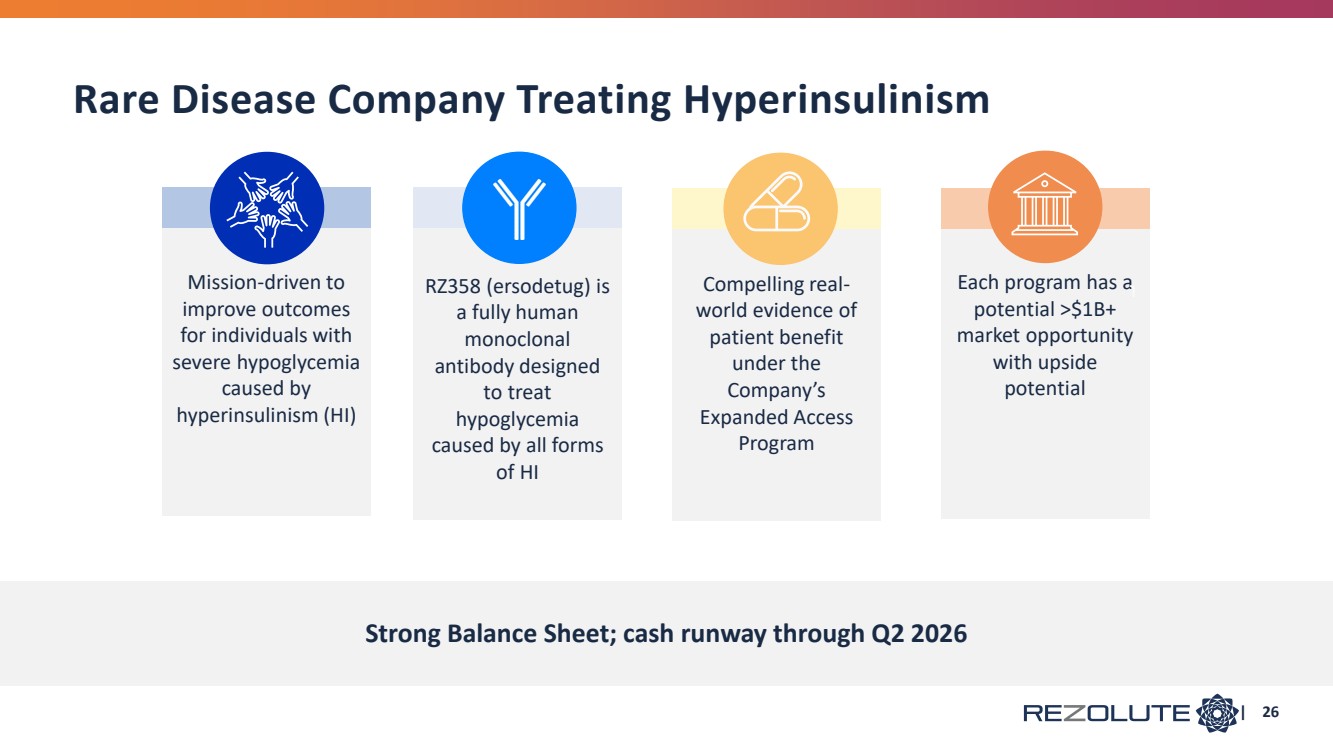EXHIBIT 99.2
Published on August 5, 2024
|
Late-stage Rare Disease Company Treating Hyperinsulinism Corporate Presentation NASDAQ: RZLT |
|
Forward Looking Statements | 2 This presentation, like many written and oral communications presented by Rezolute and our authorized officers, may contain certain forward-looking statements regarding our prospective performance and strategies within the meaning of Section 27A of the Securities Act and Section 21E of the Securities Exchange Act of 1934, as amended. We intend such forward-looking statements to be covered by the safe harbor provisions for forward-looking statements contained in the Private Securities Litigation Reform Act of 1995 and are including this statement for purposes of said safe harbor provisions. Forward-looking statements, which are based on certain assumptions and describe future plans, strategies, and expectations of Rezolute, are generally identified by use of words such as "anticipate," "believe," "estimate," "expect," "intend," "plan," "project," "prove," "potential," "seek," "strive," "try," or future or conditional verbs such as "predict," "could," "may," "likely," "should," "will," "would," or similar expressions. These Forward-Looking statements include, but are not limited to, statements regarding the sunRIZE clinical study, the RIZE study, the Investigational New Drug (IND) application for RZ358 (Ersodetug), the ability of RZ358 to become an effective treatment, the effectiveness or future effectiveness of RZ358 as a treatment, statements regarding clinical trial timelines for the treatment. Our ability to predict results or the actual effects of our plans or strategies is inherently uncertain. Accordingly, actual results may differ materially from anticipated results. Readers are cautioned not to place undue reliance on these forward-looking statements, which speak only as of the date of this release. Except as required by applicable law or regulation, Rezolute undertakes no obligation to update these forward-looking statements to reflect events or circumstances that occur after the date on which such statements were made. Important factors that may cause such a difference include any other factors discussed in our filings with the SEC, including the Risk Factors contained in the Rezolute’s Annual Report on Form 10-K and Quarterly Reports on Form 10-Q, which are available at the SEC’s website at www.sec.gov. You are urged to consider these factors carefully in evaluating the forward-looking statements in this release and are cautioned not to place undue reliance on such forward-looking statements, which are qualified in their entirety by this cautionary statement. This presentation shall not constitute an offer to sell or the solicitation of an offer to buy, nor shall there be any sale of these securities in any state or other jurisdiction in which such offer, solicitation or sale would be unlawful prior to registration or qualification under the securities laws of any such state or other jurisdiction. |
|
Seasoned management team with demonstrated success from early development through commercialization Each program is a potential >$1B+ market opportunity with additional upside with market expansion Compelling real-world evidence of patient benefit under the Company’s Expanded Access Program Two rare disease Phase 3 programs evaluating ersodetug to treat hypoglycemia in congenital HI and tumor HI RZ358 (ersodetug) is a fully human monoclonal antibody designed to treat hypoglycemia caused by all forms of hyperinsulinism (HI) Rare Disease Company Treating Hyperinsulinism | 3 |
|
Management Team | 4 Nevan Charles Elam Founder & Chief Executive Officer Brian Roberts Chief Medical Officer Daron Evans Chief Financial Officer Susan Stewart Chief Regulatory Officer Michael Deperro SVP, Corporate Development |
|
Program Target IND-Enabling Phase 1 Phase 2 Phase 3 Next Milestone Milestone Expected RZ358 (ersodetug) Congenital Hyperinsulinism (cHI) Topline data Mid-2025 RZ358 (ersodetug) Tumor Hyperinsulinism (tHI) Patient enrollment in Phase 3 study 1H 2025 Two Phase 3 Rare Disease Indications Targeting Hyperinsulinism | 5 |
|
RZ358 Treatment for Hyperinsulinism (HI) Ersodetug |
|
GLUT4 INSULIN or IGF-2 GLUCOSE RZ358 Reduces Signaling Increases Available Blood Glucose GLUT4: glucose transporter type 4. | 7 o Ersodetug allosterically binds to the insulin receptor to modulate the signaling effect of insulin and IGF-2 to maintain glucose values in a healthy range o Novel mechanism operates downstream to counteract excess insulin receptor activation o Administered by IV infusion every 2 to 4 weeks Reduces Glucose Uptake Antibody Designed to Treat All Forms of HI |
|
Rare disease caused by tumors that produce insulin or insulin-like substances such as IGF-2 Rare pediatric genetic disease characterized by excessive insulin production Hypoglycemia as a Result of HI congenital HI (cHI) tumor HI (tHI) Ersodetug has shown substantial benefit in studies and real-world use for treatment of cHI and tHI | 8 Hypoglycemia o Severe, persistent, life-threatening complication of over activation of the insulin receptor o Consequence of multiple forms of HI o Lack of effective treatment options |
|
Congenital HI Congenital HI |
|
o ~2000 individuals in the U.S. that would be candidates to use ersodetug • 1 in 28,000 live births in the US • 25 years of treatment required on average • ~3500 cases in the US • Often presents within first month of life o Most common cause of persistent hypoglycemia in infants and children o Symptoms often not recognized until life-threatening o Risk of coma, death, and other serious complications o 50% of children have neurological deficiencies o No therapy has been developed and approved for chronic treatment Disease Background | 10 |
|
o Diazoxide (DZ) is the current standard of care and only approved treatment for hypoglycemia caused by HI o 50% of patients do not respond to DZ o May experience frequent and serious adverse reactions • FDA black box for pulmonary hypertension o Patients report1 intolerable side effects and would welcome an alternative treatment option • Increased body hair (85%) • Loss of appetite (36%) • Swelling (25%) • Stomach pain/upset stomach (23%) • Facial changes (22%) Standard of Care for HI is Inadequate Source: 1) HI Global Registry 2022 Annual Report: 165 patients surveyed, 134 have taken DZ. | 11 |
|
Marginal efficacy, effects wane with repeat dosing Gastrointestinal side effects Risk of necrotizing enterocolits, particularly in newborns Potential interaction with pituitary hormones (growth and thyroid) Glucagon Current formulations short-acting Temporary measure for emergent glucose correction Repeated use may deplete liver glucose stores Long-term efficacy is modest Somatostatin Analogues (SSAs) Pancreatectomy Invasive procedure, not done globally Hypoglycemia may persist for years in up to half of patients Requires adjuvant medical management, and/or repeat surgery Eventually insulin therapy required Resection for diffuse disease [Off label] Resection for focal disease Limited number of overall cases Only done at specialized centers Can be curative for patients Frequent, glucose-enriched oral feeds or continuous enteral tube feeds Multifactorial feeding aversions affect a large proportion of children with cHI Negative impact on normal daily activities and social interactions Carbohydrate Supplementation Other Available Treatment Options are Suboptimal | 12 |
|
o 23 participants • Average age ~6.5 (16 participants were between 2-6 years of age) • Diverse group across gender and genetics o ~20% average daily time in hypoglycemia and 13 hypoglycemia events per week at baseline • Participants were on SOC o Generally safe and well-tolerated • No adverse drug reactions • No study terminations • No clinically-significant hyperglycemia or hyperglycemia AEs o Study exceeded expectations for glucose correction: • Improvement in time in hypoglycemia and overall events of up to ~90% at top doses • Nearly universal response rate at the top dose o Predictable and dose-dependent pharmacokinetics SOC: standard of care. AEs: adverse events. | 13 Phase 2b RIZE Study Results |
|
Baseline End of Treatment 0 5 10 15 Time by CGM [N=15∧] % Time (Median) -61% p < 0.0005 Baseline End of Treatment 0 5 10 15 Event Rate by BGM (N=15∧) Events Per Week (Median) p < 0.0005 - 74% Hypoglycemia (<70 mg/dL) Severe Hypoglycemia (<50 mg/dL) Baseline End of Treatment 0 1 2 3 4 Time by CGM [N=15∧] % Time (Median) -76% p< 0.05 Baseline End of Treatment 0 1 2 3 4 Event Rate by BGM (N=15∧) Events Per Week (Median) p < 0.001 - 89% BGM: blood glucose monitoring. CGM: continuous glucose monitoring. One 9 mg/kg participant excluded from analyses for stopping background therapy while on study; two others wore CGM incorrectly which impacted efficacy by CGM but were included in analyses. | 14 Substantial Improvement in All Hypoglycemia Metrics Improvement in time in hypoglycemia and overall events of ~75% and up to ~90% at top doses Pooled 6 and 9 mg/kg dose levels representative of Phase 3 population and dosing |
|
| 15 2-Year-Old on SSA 6-Year-Old; Failed meds, pancreatectomy Average Daily Time in Hypoglycemia ~40% Average Daily Time in Hypoglycemia ~45% Baseline CGM period (≥10 days) Treatment Evaluable CGM (2-weeks) RZ358 9 mg/kg On Treatment RZ358 6 mg/kg On Treatment Baseline End of Treatment 0 10 20 30 40 50 % Time Hypoglycemia 93% Improvement SSA: Somatostatin Analog. CGM: continuous glucose monitoring. Compelling Patient Responses Nearly universal patient response rate (>50% hypoglycemia correction) observed at mid and top doses |
|
o Multi-center, double-blind, randomized, controlled, safety and efficacy registrational study o Patient population (n=56) • Ages 3 months and above who have not achieved adequate glycemic control with standard of care medical management o Primary endpoint: change in average hypoglycemia events per week • Secondary endpoints include change in average daily percent time in hypoglycemia, change in severe hypoglycemia events and time, time in a target glucose range, and symptomatic hypoglycemia events o Pivotal treatment arms • ~48 participants ages 1 year and above randomized in double blind, placebo-controlled fashion • Three bi-weekly loading doses, then 4 monthly doses over a total 6-month treatment period • 5 mg/kg (+ SOC) (n = 16) • 10 mg/kg (+ SOC) (n = 16) • Placebo (SOC only) (n = 16) • Open label treatment arm: ~8 participants ages 3 months to 1 year • Eligible participants may continue in a long-term extension study following pivotal treatment o Topline results expected mid-2025 | 16 Phase 3: The sunRIZE Study SOC: standard of care. |
|
Immediately Addressable U.S. Market | 17 Diazoxide (DZ) (up to 15 mg/kg/day) Unacceptable Side Effects Tolerated Focal Diffuse After ~5-Day DZ Use: ~30% (420 pts) ~75% (1575 pts) 40% 60% Responsive Unresponsive ~3,500 Diagnosed cHI Patients in US* ~25% (525 pts) ~70% (980 pts) Addressable population of ~2,000 with an average treatment duration of 25+ years Diagnosis and Treatment Pathway Illustrates that ~2,000 Individuals are Addressable HI: hyperinsulinism. DZ: Diazoxide. DZR: Diazoxide Responsive. DZNR: Diazoxide Non-Responsive (kATP channel defect). *Similar numbers in EU |
|
o ~10K individuals in primary markets • 1 in 28,000 live births and up to 1 in 2,500 live births in certain populations due to consanguinity • In addressable patient population, disease persists for more than 25 years on average o At Launch >50% of the market is addressable • <50% of patients are adequately managed by standard of care • Growing percentage of patients on standard of care experience unacceptable side effects o Rapid patient identification and concentrated prescriber base enables accelerated adoption • 60% of patients are diagnosed within 1 month of presentation • 80% of patients are managed at centers of excellence that are participating the Phase 3 clinical trial o Regulatory Designations: Orphan, Pediatric Rare Disease (FDA), PRIME (EMA), ILAP (UK) o Potential for expanded indications such as tumor HI HI: hyperinsulinism. | 18 Addressable Worldwide Market $1B+ market opportunity with rare disease pediatric disease drug pricing |
|
Tumor HI |
|
o ~1,500 immediately addressable individuals with severe, refractory hypoglycemia in the U.S. o Hypoglycemia caused by two distinct tumor types: • Islet Cell Tumors (ICT) • Excessive secretion of insulin • Malignant insulinomas are the most common ICTs that cause hypoglycemia • Non-Islet Cell Tumors (NICT) • Produce and secrete insulin-like substances such as IGF-2 that over-activate the insulin receptor • Hepatocellular carcinomas (HCC) are the most common NICTs that cause hypoglycemia o Significant unmet need across both tumor types • Resulting hypoglycemia is often severe and may have serious adverse outcomes • Limited treatment options with poor efficacy and safety profiles • High morbidity and mortality rates • Can require hospitalization (often prolonged and in ICU) and interferes with patient quality of life • May prevent adjuvant tumor treatment Disease Background | 20 |
|
o Tumor-directed therapies do not directly treat hypoglycemia • Adequate hypoglycemia management is required prior to initiation of tumor-targeted therapies o Therapies to treat malignant insulinoma are often ineffective or poorly tolerated • Diazoxide (DZ) is the only approved treatment • Suboptimal response rates and serious side effects • Somatostatin analogs (SSAs) • Used off-label with limited success • May worsen hypoglycemia in tumor HI setting • mTOR-inhibitors • Used off-label and have potentially severe side effects o Limited and often ineffective treatment options for hepatocellular carcinoma (HCC) • Medical therapies directed at suppressing insulin secretion such as DZ and SSAs do not work in non-islet cell tumors (NICTs) where HI is caused by non-insulin substances such as IGF-2 Treatment Options and Unmet Need | 21 |
|
o Multiple ICT patients with severe refractory hypoglycemia • Hospitalized and in life-threatening or hospice-bound condition • Required continuous high volume/concentration intravenous dextrose or nutritional infusion • Tumor-directed therapies (e.g., embolization, radiotherapy, chemotherapy) deferred because of hypoglycemia • Physician-requested use of ersodetug o Administration of ersodetug resulted in: • Substantial hypoglycemia improvement with no significant side effects • Discontinuation of intravenous dextrose • Discharge from in-patient to out-patient care • Resumption of tumor-directed therapies Real-world Patient Benefit Under EAP EAP: Expanded Access Program. Sources: n engl j med 389;8 Aug24,2023 - | 22 https://www.nejm.org/doi/full/10.1056/NEJMc2307576?query=TOC&cid=NEJM+eToc%2C+August+24%2C+2023+DM2279684_NEJM_Non_Subscriber&bid=1754093795 |
|
Phase 3 Study Overview o Multi-center, double-blind, randomized, controlled, safety and efficacy registrational study o Patient population (n= up to 48) • Adult ICT and NICT patients with HI who have not achieved adequate hypoglycemia control with SOC therapies • 24 participants in double-blind, placebo-controlled arm (to evaluate primary endpoint/hypoglycemia events) • Up to 24 participants in open label arm: initial 6 NICT patients and any hospitalized participants on IV glucose o Primary endpoint: change in average hypoglycemia events per week by self-monitored blood glucose • Secondary/additional endpoints: change in average daily percent time in hypoglycemia, change in Level 1 hypoglycemia events and time, hospitalization, patient reported quality of life • Open-label arm to evaluate change in IV glucose requirements in hospitalized participants o Treatment arms and dosing regimen • Once weekly administration over 6-week pivotal treatment period • 9 mg/kg RZ358 (+ SOC) (n = 12) • Matched placebo (SOC only) (n = 12) • 9 mg/kg RZ358 Open Label Arm (n ≤ 24) • Eligible participants may continue in a long-term extension study following pivotal treatment o IND filed and cleared: start-up activities in progress to enable patient enrollment in 1H 2025 ICT: islet-cell tumor. NICT: non-islet cell tumor. SOC: standard of care. | 23 |
|
Immediately Addressable U.S. ICT Market | 24 ~300 pts ~30% ~25% ~1,5002 patients ~500 Addressable Patients with Severe/Refractory Hypoglycemia Malignant Insulinoma Hypoglycemia (Hypo) Diagnosis and Treatment Pathway1 ICT: islet cell tumor. Source: 1) Based on analysis of seven years of data from the Komodo Claims Assessment; 2) Approximate, average prevalence of patient with both malignant insulinoma and diagnosed hypoglycemia. Medical Management for Hypo Mild Hypo (No treatment) 80% 20% De-bulking Surgery Hypo Not Adequately Managed Hypo Adequately Managed ~45% Refractory Hypo, Post-Sugery No Further Treatment Provided ~40% ~60% ~215 pts |
|
Immediately Addressable U.S. NICT Market | 25 ~560 pts ~45% ~25% ~4,5002 patients ~1,000 Addressable Patients with Severe/Refractory Hypoglycemia Hepatocellular Carcinoma + Hypoglycemia (Hypo) Diagnosis and Treatment Pathway1 NICT: non-islet cell tumor. Source: 1) Based on analysis of seven years of data from the Komodo Claims Assessment; 2) Approximate, average prevalence of patient with both malignant insulinoma and diagnosed hypoglycemia Medical Management for Hypo Mild Hypo (No treatment) 50% 50% De-bulking Surgery Hypo Not Adequately Managed Hypo Adequately Managed ~30% Refractory Hypo, Post-Sugery No Further Treatment Provided ~40% ~60% ~405 pts |
|
Each program has a potential >$1B+ market opportunity with upside potential Compelling real-world evidence of patient benefit under the Company’s Expanded Access Program RZ358 (ersodetug) is a fully human monoclonal antibody designed to treat hypoglycemia caused by all forms of HI Mission-driven to improve outcomes for individuals with severe hypoglycemia caused by hyperinsulinism (HI) Rare Disease Company Treating Hyperinsulinism | 26 Strong Balance Sheet; cash runway through Q2 2026 |
|
